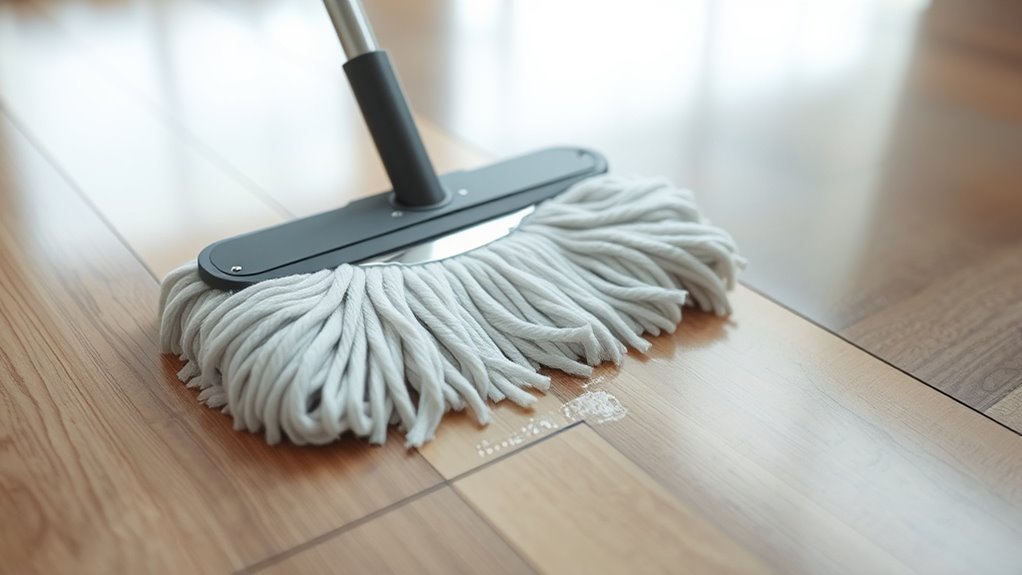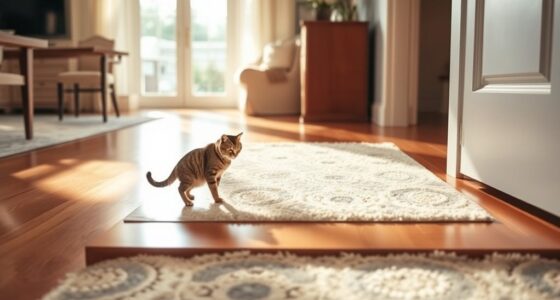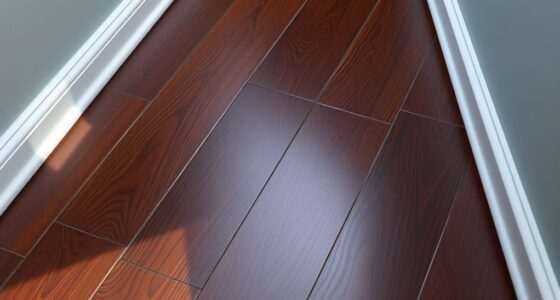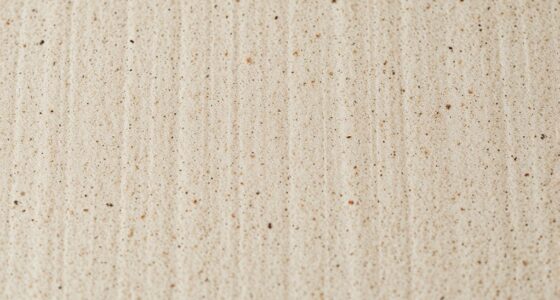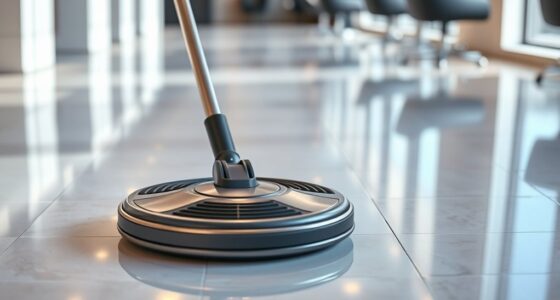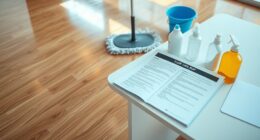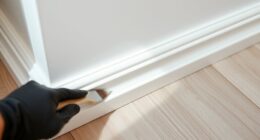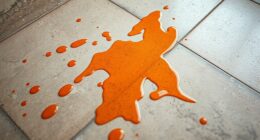When damp mopping your laminate floors, make certain the mop is only slightly moist, with just a few drops of water; avoid soaking it. Wring it thoroughly so no excess water remains, and use gentle, controlled strokes. Excess moisture can seep into seams and damage the core layers, causing swelling or warping. Keep your floors safe and looking their best—learn more about maintaining proper dampness and spotting early water damage signs.
Key Takeaways
- Use a microfiber or cotton mop that is damp, not soaking wet, ensuring minimal excess water.
- Wring the mop thoroughly until only a few drops of water remain before cleaning.
- Avoid pouring or spraying large amounts of water directly onto the floor during mopping.
- Follow with a dry microfiber cloth or mop to remove residual moisture after damp mopping.
- Regularly check for standing water or puddles and wipe them up immediately to prevent damage.
Understanding Laminate Floor Construction and Its Sensitivity to Water
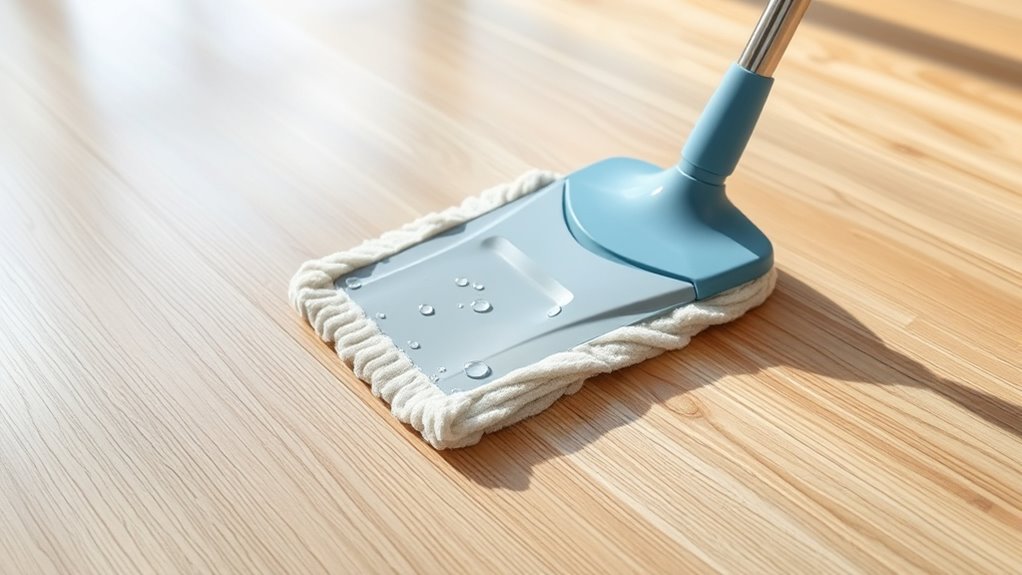
Laminate floors are composed of multiple layers, including a high-density fiberboard core topped with a photographic layer that mimics wood or other materials, and a protective wear layer. This construction gives laminate its durability and realistic appearance. However, the core layer is sensitive to moisture, especially water that seeps into seams or gaps. When water penetrates, it can cause the fiberboard to swell, warp, or peel. The photographic layer and wear layer are less resistant to water damage, making them vulnerable if excess moisture is present. Knowing this, you understand why keeping water on the surface minimal is essential. Properly maintaining your laminate involves avoiding excessive wetness, especially during cleaning, so you can preserve its appearance and structural integrity over time.
The Risks of Excessive Moisture on Laminate Surfaces
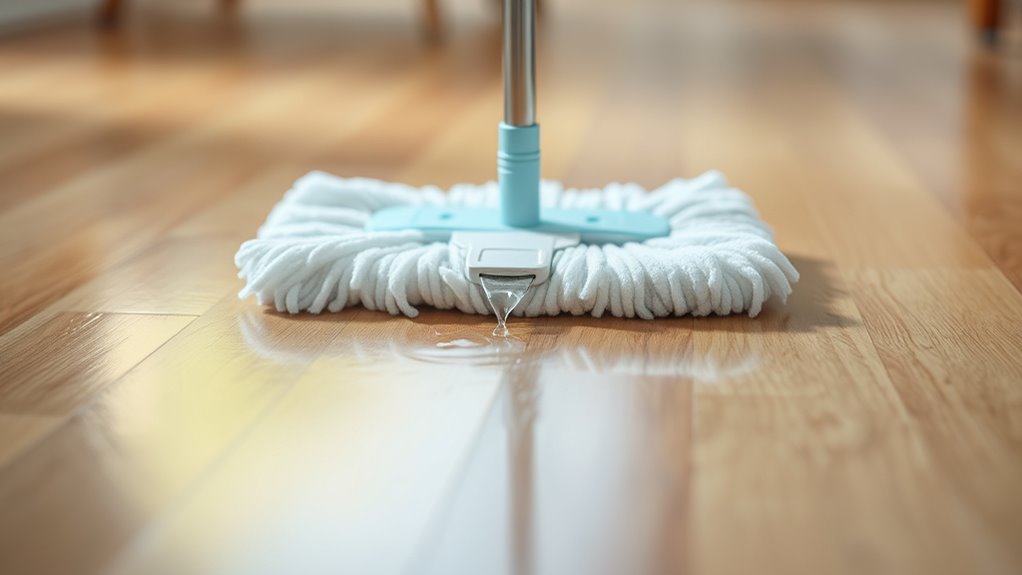
Excessive moisture poses a significant threat to laminate floors, as water can quickly seep into the seams and gaps, causing damage beneath the surface. This can lead to swelling, warping, and delamination over time. The damage isn’t always visible right away, so you might not notice until it’s severe. To understand the risks better, consider this table:
| Damage Type | Causes | Consequences |
|---|---|---|
| Swelling | Excessive wet mopping | Floor buckling and unevenness |
| Warping | Standing water or leaks | Surface distortion |
| Delamination | Prolonged moisture exposure | Layers separating, surface damage |
Being cautious with moisture levels helps preserve your laminate’s appearance and longevity. Understanding these damage types can help you avoid costly repairs and maintain a beautiful floor.
How to Prepare Your Mop for Safe Cleaning

Before mopping, make sure you use a proper cleaning solution that’s safe for laminate floors. Wring out your mop thoroughly to avoid excess water, which can cause damage. Always test your cleaning method on a small, hidden area first to prevent potential issues.
Use Proper Cleaning Solution
To guarantee your laminate floors stay protected, it’s vital to use the right cleaning solution. Stick to a gentle, pH-neutral cleaner specifically designed for laminate or hardwood floors. Avoid harsh chemicals, bleach, or abrasive detergents, as they can damage the surface. If you prefer a DIY solution, mix a few drops of mild dish soap with warm water. Never use straight vinegar or ammonia, as they can dull the finish. Before cleaning, test the solution on a small, inconspicuous area to make sure it doesn’t cause discoloration. Using the proper cleaner ensures dirt and grime lift easily without compromising the protective coating on your laminate. This step helps you safely maintain your floors while avoiding unnecessary damage. Additionally, choosing a suitable cleaning method can prevent excess moisture from seeping into the seams and causing warping or swelling.
Wring Excess Water Out
Wringing out your mop thoroughly is essential to prevent excess water from seeping into your laminate floors. If your mop is too wet, water can penetrate the seams and cause damage over time. To prepare your mop for safe cleaning, follow these steps:
- Squeeze the mop head firmly to remove most of the water.
- Spin the mop in a wringer or spin bucket to extract additional moisture.
- Check the mop for drips; it should be damp, not dripping.
- Reassess and wring again if necessary until the mop feels just damp.
Test on Small Area
Wondering how to guarantee your mop won’t damage your laminate floors? Start by testing your cleaning method on a small, inconspicuous area first. Dampen your mop slightly—no drips or pooling—and gently wipe a small section. Wait a few minutes to check for any warping, discoloration, or other damage. If your floor looks fine, proceed with confidence, but if you notice issues, adjust your approach immediately. This test ensures your mop’s moisture level is safe for your laminate. Always remember, the goal is to keep the floor moist, not soaked. Taking this extra step prevents costly damage and helps you clean effectively without risking your investment. A small initial test is a simple, smart way to protect your floors. Additionally, understanding the influence of AI on cleaning tools can help you choose more advanced, safer cleaning solutions.
Determining the Ideal Level of Dampness for Mopping
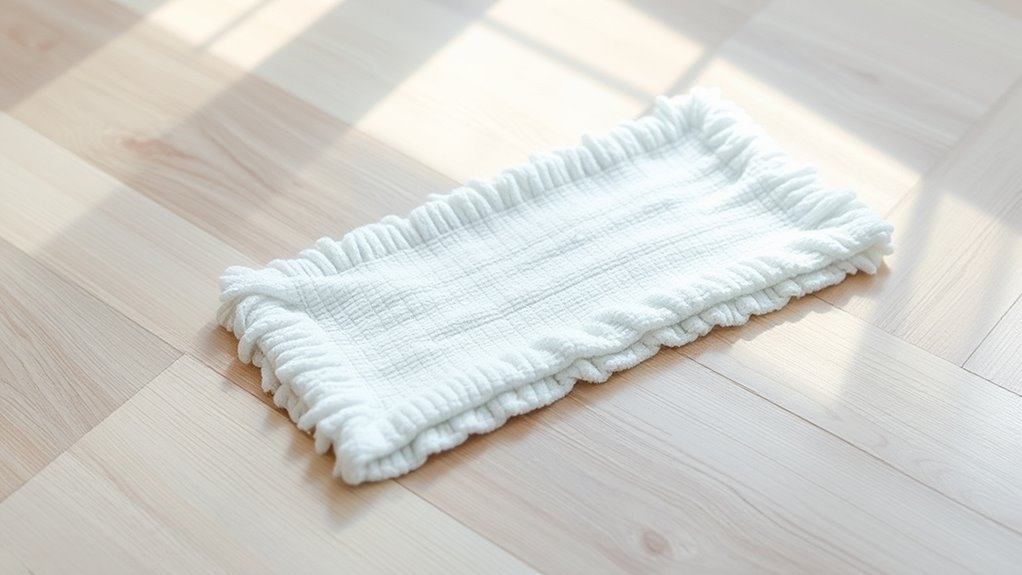
To keep your laminate floors safe, you need to use the right amount of moisture when mopping. Using ideal moisture levels and proper techniques helps prevent damage and ensures a thorough clean. Watch for signs of excess wetness, like puddles or streaks, to adjust your approach accordingly. Additionally, understanding the signs of spoilage in cleaning liquids can help you avoid using compromised products that might harm your flooring.
Optimal Moisture Levels
Finding the right moisture level is key to effectively mopping laminate floors without causing damage. You want enough dampness to lift dirt without soaking the surface. Aim for a cloth or mop that’s just slightly moist, not dripping. To achieve this, consider these guidelines:
- Wring out your mop thoroughly until only a few drops remain.
- Check for excess water by pressing the mop against your hand—if it’s wet, wring out more.
- Avoid saturating the mop; a damp cloth is sufficient.
- Use a microfiber or cotton mop, as they hold less water and distribute moisture evenly.
- Regularly monitor the moisture level to prevent water damage, which can cause warping or swelling of laminate flooring.
Keeping moisture levels low prevents warping, swelling, or delamination. Remember, less is more when it comes to mopping laminate floors.
Proper Mopping Techniques
Achieving the ideal dampness when mopping laminate floors is essential for effective cleaning and preventing damage. Use a microfiber mop or cloth, wring it out thoroughly so it’s just damp, not soaking. Avoid dripping water; it can seep into seams and cause warping. Focus on using smooth, controlled strokes, cleaning small sections at a time. Remember, the goal is to lift dirt without flooding the surface. Being aware of pinball machine weight is crucial if you plan to move furniture or equipment around during cleaning.
Signs of Excess Wetness
Excess wetness becomes immediately noticeable when your mop leaves puddles or drips with every pass. Look for these signs:
- Standing water on the floor after mopping, which can cause warping or swelling.
- Drips or streaks that don’t dry quickly, indicating too much moisture.
- Slippery surfaces that feel slick, increasing the risk of slips.
- Watermarks or streaks that remain for a while, showing you’ve used excess liquid.
- Ignoring proper mindfulness during cleaning can lead to over-saturation, which may harm your laminate flooring over time.
If you notice these signs, your floor isn’t dry enough and may be damaged over time. Maintaining the right dampness ensures effective cleaning without risking your laminate’s integrity. Always aim for a damp, not soaked, mop for safe and efficient mopping.
Techniques for Effective and Safe Damp Mopping

To make certain your laminate floors stay clean and undamaged, it’s essential to use proper damp mopping techniques. Start by filling a bucket with warm water and adding a small amount of laminate floor cleaner or a mild dish soap. Wring out your mop thoroughly so it’s just damp, not wet. Avoid soaking the mop, as excess water can seep into seams and cause damage. Use smooth, controlled strokes to clean the surface, focusing on high-traffic areas. Rinse and wring the mop frequently to prevent spreading dirt. After mopping, go over the floor with a dry microfiber cloth or mop to remove any remaining moisture. This approach helps keep your floors clean while preventing warping or swelling caused by excess water. Additionally, choosing a sulfate-free cleaner can help preserve the finish and color of your laminate floors.
Signs That Your Laminate Floors Are Suffering From Water Damage
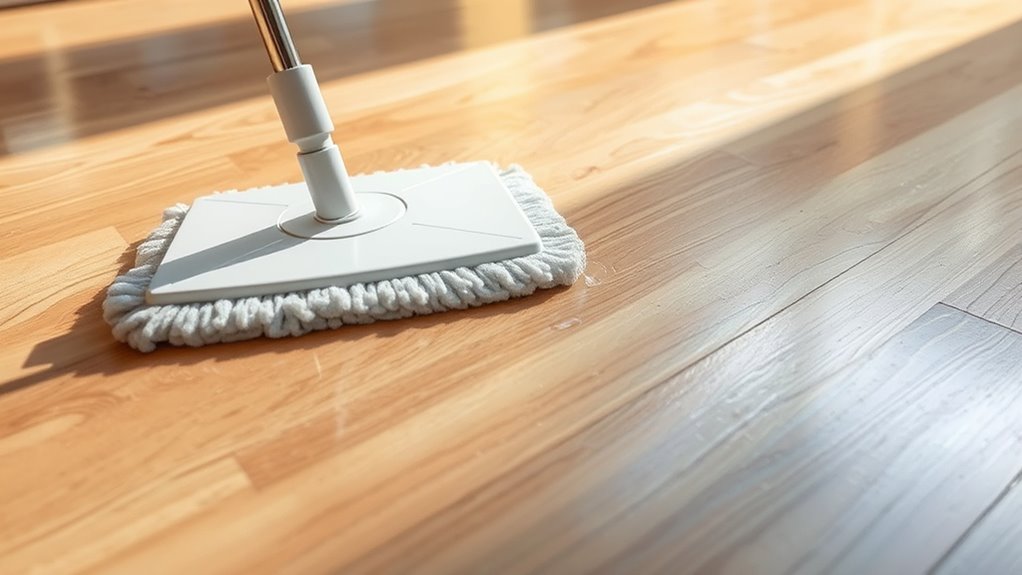
While proper damp mopping techniques help protect your laminate floors, water damage can still occur if moisture seeps into the seams or under the surface. You should watch for signs like:
- Warping or buckling of the floor planks
- Swelling or bubbling in specific areas
- Discoloration or dark spots appearing on the surface
- Vinyl or laminate edges lifting or separating
If you notice any of these, it’s a clear sign water has penetrated the surface. Ignoring these indicators can lead to further damage and costly repairs. Stay vigilant and inspect your floors regularly, especially after cleaning. Addressing water damage early helps preserve the integrity and appearance of your laminate flooring.
Tips for Maintaining a Clean and Dry Laminate Floor Environment
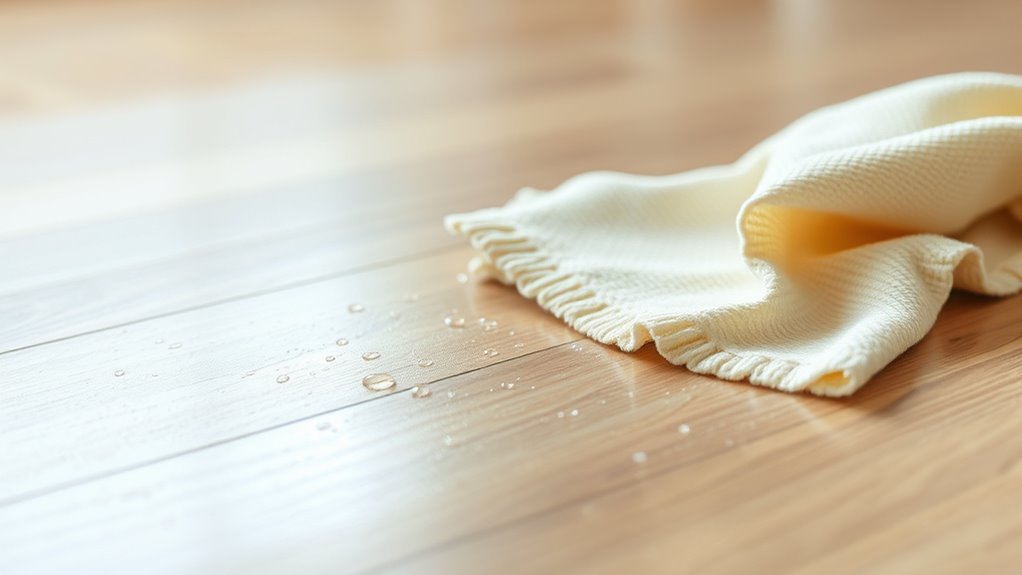
Maintaining a clean and dry laminate floor environment is essential for preserving its appearance and preventing water damage. To do this, sweep regularly to remove dirt and debris that can scratch the surface. Use a damp mop with a well-wrung cloth—avoid soaking it—to pick up dirt without leaving excess water. Immediately wipe up spills to prevent moisture from seeping into seams. Place mats at entryways to catch dirt and moisture before it reaches your floors. Use furniture pads to prevent scratches and avoid dragging heavy objects. Keep humidity levels in check with a dehumidifier or proper ventilation, especially in humid months. Regular maintenance and mindful cleaning habits help guarantee your laminate floors stay looking fresh and remain damage-free for years. Additionally, monitoring air quality indicators can help identify excess moisture or pollutants that may compromise your flooring over time.
Frequently Asked Questions
Can I Use a Steam Mop on Laminate Floors?
You can use a steam mop on laminate floors if you’re careful. Make sure the steam mop releases minimal moisture, and don’t hold it in one spot too long. Always check your flooring manufacturer’s recommendations first. Use the lowest heat and steam setting to avoid warping or damaging the laminate. When done, wipe any excess moisture quickly with a dry cloth to keep your floors safe and shiny.
How Often Should I Damp Mop My Laminate Flooring?
You should damp mop your laminate floors once a week to keep them clean without risking damage. Too frequent mopping can cause water to seep into seams, leading to warping or swelling. When you mop, make sure the cloth is only slightly damp—not dripping—to prevent excess moisture. Regularly check your floor’s condition and adjust your cleaning routine if you notice any signs of moisture damage or dirt buildup.
What Type of Cleaning Solutions Are Safest for Laminate Floors?
You should use cleaning solutions specifically designed for laminate floors or a mixture of water and a few drops of gentle dish soap. Avoid harsh chemicals, ammonia, or abrasive cleaners, as they can damage the surface. Always opt for a slightly damp mop rather than soaking it, and make sure to wring out excess water thoroughly. This approach keeps your laminate floors clean without risking warping or staining.
Is It Safe to Leave Water on Laminate Surfaces Overnight?
You shouldn’t leave water on laminate surfaces overnight. Excess moisture can seep into the seams and cause warping, swelling, or damage to the flooring over time. Always wipe up any spills promptly and avoid excessive water during cleaning. Use a damp cloth rather than a soaked mop, and make certain the floor dries quickly. This way, you protect your laminate floors and keep them looking their best for years.
Can I Repair Water Damage Once It Occurs on Laminate Floors?
Absolutely, you can repair water damage on laminate floors. First, identify the extent of the damage—if it’s minor, you might sand and refinish the affected area. For more severe damage, replacing the damaged planks is necessary. Don’t delay; even in the age of steam-powered machines, water damage remains fixable if you act promptly. Always guarantee the area is thoroughly dried before repairs to prevent mold or further warping.
Conclusion
So, next time you grab that mop, remember—less water means more peace of mind. It’s funny how a simple damp cloth can save you from costly repairs, yet many still risk it with excessive moisture. Keep your floors dry and your worries at bay; after all, a little less wetness goes a long way. Sometimes, the best way to clean is simply to let your floors breathe—without drowning them in the process.
